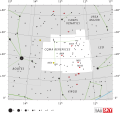A dwarf nova (pl. novae), or U Geminorum variable, is one of several types of cataclysmic variable star, consisting of a close binary star system in which...
7 KB (701 words) - 22:14, 21 February 2025
star (hence the name "nova", Latin for "new") that slowly fades over weeks or months. All observed novae involve white dwarfs in close binary systems...
29 KB (3,093 words) - 01:41, 15 March 2025
the inner edge of disc falls onto the surface of the white dwarf primary. A classical nova outburst occurs when the density and temperature at the bottom...
12 KB (1,009 words) - 23:13, 4 March 2025
its Roche lobe so that matter is transferred to the white dwarf and accumulates until a nova-like outburst occurs, caused by ignition of thermonuclear...
3 KB (373 words) - 18:31, 3 August 2024
V339 Delphini (redirect from Nova Delphini 2013)
the white dwarf nova progenitor acquired from its companion star. The nova system is thus a binary star, and a classical nova. The white dwarf is a carbon-oxygen...
8 KB (683 words) - 10:59, 22 August 2024
could also exist brown dwarfs that merged with white dwarfs. The nova CK Vulpeculae might be a result of such a white dwarf–brown dwarf merger. The earliest...
166 KB (18,155 words) - 22:24, 8 May 2025
at the predicted time. Binary star Cataclysmic variable star Dwarf nova Hypernova Nova Supernova Kulkarni, S. R.; Ofek, E. O.; Rau, A.; Cenko, S. B.;...
10 KB (1,144 words) - 20:30, 12 May 2025
WZ Sagittae (category Dwarf novae)
WZ Sagittae (WZ Sge) is a dwarf nova cataclysmic star system in the constellation Sagitta. It consists of a white dwarf primary being orbited by a low...
10 KB (1,017 words) - 19:19, 7 May 2025
fourth planetary system is unconfirmed. TV Corvi is a dwarf nova—a white dwarf and brown dwarf in very close orbit. In the Babylonian star catalogues...
51 KB (6,172 words) - 23:25, 1 March 2025
BW Sculptoris (category Dwarf novae)
Sge-type dwarf nova and a candidate period bouncer. The binary consists of a white dwarf and a brown dwarf donor that orbits the white dwarf every 78...
7 KB (703 words) - 04:50, 2 March 2025
could shed light on some hypothetical particles such as the axion. A dwarf nova has also been observed in this cluster. Globular cluster Messier 5 in...
10 KB (895 words) - 22:47, 7 May 2025
clock. SX Leonis Minoris is a dwarf nova of the SU Ursae Majoris type that was identified in 1994. It consists of a white dwarf and a donor star, which orbit...
41 KB (3,905 words) - 04:43, 4 May 2025
ultraviolet, the white dwarf HZ 43, was discovered in Coma Berenices. In 1995, there was a very rare outburst of the WZ Sagittae-type dwarf nova AL Comae Berenices...
64 KB (6,974 words) - 22:25, 3 May 2025
GK Persei (redirect from Nova Persei 1901)
seems to have changed from a classical nova like Nova Aquilae 1918 to something resembling a typical dwarf nova-type cataclysmic variable star. Surrounding...
10 KB (908 words) - 06:38, 7 October 2024
2030+ 375. Cygnus is also home to several variable stars. SS Cygni is a dwarf nova which undergoes outbursts every 7–8 weeks. The system's total magnitude...
52 KB (5,898 words) - 00:30, 4 May 2025
Compact object (section White dwarfs)
the term compact object (or compact star) refers collectively to white dwarfs, neutron stars, and black holes. It could also include exotic stars if such...
20 KB (2,589 words) - 22:40, 1 March 2025
most peculiar systems in Lyra is MV Lyrae, a nova-like star consisting of a red dwarf and a white dwarf. Originally classified as a VY Sculptoris star...
68 KB (7,584 words) - 22:17, 3 May 2025
active galactic nucleus. Galaxies can also have satellites in the form of dwarf galaxies and globular clusters. The constituents of a galaxy are formed...
29 KB (1,595 words) - 04:18, 3 May 2025
magnitude 4.8 and the secondary is a yellow star of magnitude 7.8. U Gem is a dwarf nova type cataclysmic variable discovered by J. R. Hind in 1855. M35 (NGC 2168)...
20 KB (2,270 words) - 02:22, 23 March 2025
TV Corvi (category Dwarf novae)
TV Corvi, also known as Tombaugh's Star, is a dwarf nova of the SU Ursae Majoris type in the constellation Corvus that was first discovered by accident...
7 KB (691 words) - 19:33, 24 October 2024
Gamma is the VW Hydri, a dwarf nova of the SU Ursae Majoris type. It is a close binary system that consists of a white dwarf and another star, the former...
29 KB (3,090 words) - 14:30, 2 May 2025
Australis, a dwarf nova of the SU Ursae Majoris type, was first noticed in 1978 and officially described in 1980. It consists of a white dwarf and a donor...
33 KB (3,326 words) - 01:39, 28 February 2025
SN 393 (section Suggested as classical nova)
lengthy duration suggests the source was a supernova. However, a classical nova is not excluded as possibility. Before 1975, the observation made by the...
11 KB (1,164 words) - 01:02, 23 April 2025
term is used for violent deep-sky events, such as supernovae, novae, dwarf nova outbursts, gamma-ray bursts, and tidal disruption events, as well as gravitational...
12 KB (1,324 words) - 06:35, 9 March 2025
A red dwarf is the smallest kind of star on the main sequence. Red dwarfs are by far the most common type of fusing star in the Milky Way, at least in...
36 KB (4,265 words) - 18:28, 17 May 2025
U Geminorum (category Dwarf novae)
is an archetypal example of a dwarf nova. The binary star system consists of a white dwarf closely orbiting a red dwarf. Every few months it undergoes...
9 KB (819 words) - 06:19, 6 January 2025
Superhump (category Dwarf novae)
periods slightly less than the orbital period. Superhumps can occur in dwarf nova systems in which the donor star (mass-losing star) has a mass that is...
3 KB (399 words) - 18:55, 13 September 2024
be prone to instability leading to dwarf nova outbursts: a portion of the disk material falls onto the white dwarf, the cataclysmic outbursts occur when...
20 KB (2,501 words) - 15:38, 6 March 2025
that are known to have occurred in 2019. A nova is an energetic astronomical event caused by a white dwarf accreting matter from a star it is orbiting...
10 KB (422 words) - 12:29, 6 February 2024
A black dwarf is a theoretical stellar remnant, specifically a white dwarf that has cooled sufficiently to no longer emit significant heat or light. Because...
11 KB (1,252 words) - 21:52, 18 May 2025


























